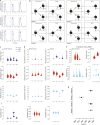The lifespan and kinetics of human dendritic cell subsets and their precursors in health and inflammation
- PMID: 39417994
- PMCID: PMC11488382
- DOI: 10.1084/jem.20220867
The lifespan and kinetics of human dendritic cell subsets and their precursors in health and inflammation
Abstract
Dendritic cells (DC) are specialized mononuclear phagocytes that link innate and adaptive immunity. They comprise two principal subsets: plasmacytoid DC (pDC) and conventional DC (cDC). Understanding the generation, differentiation, and migration of cDC is critical for immune homeostasis. Through human in vivo deuterium-glucose labeling, we observed the rapid appearance of AXL+ Siglec6+ DC (ASDC) in the bloodstream. ASDC circulate for ∼2.16 days, while cDC1 and DC2 circulate for ∼1.32 and ∼2.20 days, respectively, upon release from the bone marrow. Interestingly, DC3, a cDC subset that shares several similarities with monocytes, exhibits a labeling profile closely resembling that of DC2. In a human in vivo model of cutaneous inflammation, ASDC were recruited to the inflammatory site, displaying a distinctive effector signature. Taken together, these results quantify the ephemeral circulating lifespan of human cDC and propose functions of cDC and their precursors that are rapidly recruited to sites of inflammation.
© 2024 Lubin et al.
Conflict of interest statement
Disclosures: The authors declare no competing interests exist.
Figures









References
-
- Auffermann-Gretzinger, S., Eger L., Bornhäuser M., Schäkel K., Oelschlaegel U., Schaich M., Illmer T., Thiede C., and Ehninger G.. 2006. Fast appearance of donor dendritic cells in human skin: Dynamics of skin and blood dendritic cells after allogeneic hematopoietic cell transplantation. Transplantation. 81:866–873. 10.1097/01.tp.0000203318.16224.57 - DOI - PubMed
-
- Bachem, A., Güttler S., Hartung E., Ebstein F., Schaefer M., Tannert A., Salama A., Movassaghi K., Opitz C., Mages H.W., et al. . 2010. Superior antigen cross-presentation and XCR1 expression define human CD11c+CD141+ cells as homologues of mouse CD8+ dendritic cells. J. Exp. Med. 207:1273–1281. 10.1084/jem.20100348 - DOI - PMC - PubMed
-
- Binnewies, M., Mujal A.M., Pollack J.L., Combes A.J., Hardison E.A., Barry K.C., Tsui J., Ruhland M.K., Kersten K., Abushawish M.A., et al. . 2019. Unleashing type-2 dendritic cells to drive protective antitumor CD4+ T cell immunity. Cell. 177:556–571.e16. 10.1016/j.cell.2019.02.005 - DOI - PMC - PubMed
-
- Bosteels, C., Neyt K., Vanheerswynghels M., van Helden M.J., Sichien D., Debeuf N., De Prijck S., Bosteels V., Vandamme N., Martens L., et al. . 2020. Inflammatory type 2 cDCs acquire features of cDC1s and macrophages to orchestrate immunity to respiratory virus infection. Immunity. 52:1039–1056.e9. 10.1016/j.immuni.2020.04.005 - DOI - PMC - PubMed
MeSH terms
Substances
Grants and funding
LinkOut - more resources
Full Text Sources
Molecular Biology Databases
Research Materials
Miscellaneous

